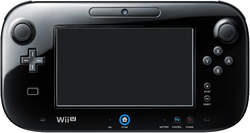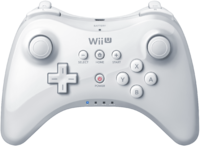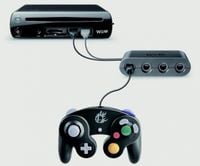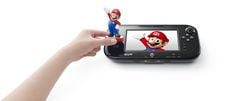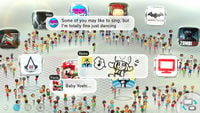Wii U
- Not to be confused with Wii.
| Wii U | |
|---|---|
Official logo 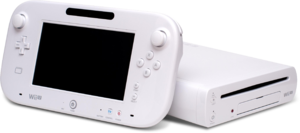 Wii U system (right) and its GamePad controller (left) | |
| Generation | Eighth generation |
| Release dates | |
| Discontinued | |
| Predecessor | Wii |
| Successor | Nintendo Switch |
- “How U Will Play Next”
- —Advertisement slogan for the Wii U
The Wii U is an eighth-generation home video game console produced by Nintendo as the successor to the Wii. It is Nintendo's first home console since the Super Nintendo Entertainment System to share a portion of its name with its predecessor. During development, the console was codenamed "Project Café." It was announced during Nintendo's conference at E3 2011. The main feature of the Wii U is its controller, the Wii U GamePad, which has a touch screen, a camera, a microphone, and other features. According to Yoshiaki Koizumi, the Wii U was never shown to Nintendo's software development team prior to its unveiling at E3 2011. With the name "Wii" originating from the word "we," the "U" ("you") was added to reflect the console's intended appeal to single-player play as well as multiplayer. It is the home console counterpart of the Nintendo 3DS.
The Wii U was released in the United States on November 18, 2012; in Europe and Australia on November 30, 2012; and in Japan on December 8, 2012. The Wii U was the third Nintendo console to be released in North America before Japan, the other two being the Wii and the original Nintendo DS. It is also the first Nintendo home console since the NES to be released before its competitors' consoles of the same generation were announced, and the first Nintendo console since that system to use standard audio/video cables, as it supports HDMI and comes with its own HDMI cable; by extent, it is the first Nintendo home console since the Nintendo GameCube to support digital audio/video output as well. The system can also use the Wii's composite AV or component AV cables to hook up to older TV sets that do not support HDMI.
In contrast to the Wii, the Wii U was not very successful when compared to its contemporaries, Sony's PlayStation 4 and Microsoft's Xbox One. It was initially expected to sell 100 million units;[11] however, it managed to sell only 13.56 million units worldwide,[12] making it Nintendo's least successful home console, a record previously held by the Nintendo GameCube. Because of this, the Wii U was discontinued in Europe on October 1, 2016; in North America on November 10, 2016; in Australia on November 14, 2016; and in Japan on January 31, 2017, only about four years after the console's initial release. The Wii U's lifetime sales were outsold in only nine months by its successor, the Nintendo Switch.[13][14] Commonly cited reasons for the Wii U's weak sales include its confusing marketing, complicated GamePad, few third-party titles (many being canceled and/or unreleased), high initial pricing, and lack of Blu-ray, DVD, and CD playback.[15] However, many first-party Wii U titles were ported to the Nintendo Switch.
Features[edit]
The Wii U console resembles the Wii, except it is much longer with rounder sides. It has a slot to insert 12-centimeter proprietary high-density optical discs based on the Blu-ray format, as well as the Wii's optical discs based on the DVD format. The console can play high-definition games at 720p and 1080p. The console itself is approximately 4.6 cm tall, 17.3 cm wide, and 26.7 cm long. When placed horizontally, it slightly resembles the Wii Family Edition. It features IBM microprocessor technology inside.
The Wii U supports all the controllers (and respective peripherals) used with the Wii: the Wii Remote, the Nunchuk controller, the Wii Remote Plus, the Classic Controller, the Classic Controller Pro, and the Wii Balance Board. It is compatible with the Wii hardware and software; similar to the Wii Family Edition and Wii mini, however, it is incompatible with the Nintendo GameCube hardware or software.[16] While the disc drive contains grips to load 8 cm GameCube discs, it will eject them almost immediately after insertion. The Wii U is the first home Nintendo console whose controllers' control sticks can be pressed down to act as extra buttons; although, the only Super Mario games that use these features are Super Mario 3D World, Captain Toad: Treasure Tracker, in which pressing the right stick resets the camera angle, and Super Mario Maker in which it is used to change the hand on the TV Screen in edit mode. It is also the first home Nintendo console whose controllers include perfectly circular analog stick movement.
The Wii U supports up to eight-player local play, as seen in Super Smash Bros. for Wii U. It was intended to be able to support two GamePads, but this was scrapped during development. The console has an internal flash memory, holding 8 GB for the standard set, and 32 GB for the deluxe set. Additionally, the Wii U has the option to expand its memory by using an external USB hard disk drive or USB stick. If the Wii U detects two USB storage devices connected to it, it will launch Data Management so that players can transfer data between the devices, and the Wii U will refuse to leave Data Management until the system has restarted with one storage device connected. The Wii U is the first Nintendo console to use industry-standardized byte units for measuring storage as earlier Nintendo consoles had used non-standardized units like "blocks" and "pages".
However, even though the Wii U has an SD Card slot that supports cards up to 32 GB (SDHC), SD cards cannot be used for Wii U data storage, meaning that Wii U game data cannot be transferred onto other Wii U systems on SD cards. Only Super Smash Bros. for Wii U screenshots, Mii storage (including photos from the Wii U version of Mii Maker), and Wii Menu data storage support SD cards.
Until its termination on April 8, 2024, the Wii U allowed players to connect to the internet using the Nintendo Network, the successor to Nintendo Wi-Fi Connection, via a wireless connection or using the Wii LAN Adapter.
Language support[edit]
The Wii U was the final Nintendo console to be region-locked and, along with the Nintendo 3DS, the first Nintendo console to support European Portuguese and Russian languages. These 12 languages were available at launch:
|
|
As the console was never released in Asian territories other than Japan, the console does not support Chinese and Korean as languages, unlike the Wii.
Peripherals[edit]
Wii U GamePad[edit]
The Wii U GamePad, or simply the GamePad, is the main controller of the Wii U console. The GamePad has a 6.2-inch (15.7-cm) 854x480px resistive touchscreen in the center, and it is the first ever controller for a home video game console to have this feature. Its button layout is somewhat similar to that of the Nintendo 3DS, having the traditional to the left of the screen and the
![]() ,
, ![]() ,
, ![]() , and
, and ![]() buttons to the right. The GamePad has two traditional
buttons to the right. The GamePad has two traditional , one on each side of the screen and over the traditional buttons. The sticks are slightly displaced nearer to the edges of the controller and are clickable. The
![]() and
and ![]() buttons are located behind the GamePad, as are the
buttons are located behind the GamePad, as are the ![]() and
and ![]() buttons. Below the screen is the
buttons. Below the screen is the button, situated between the microphone aperture and the battery light, and next to the light is the
![]() button. The
button. The ![]() select button and
select button and ![]() start button are found below the
start button are found below the ![]()
![]()
![]()
![]() buttons. The
buttons. The ![]() button is directly below the screen right to the TV button. The controller also has a
button is directly below the screen right to the TV button. The controller also has a ![]() NFC sensor, able to read objects or codes near to the controller. The GamePad can be used with a stylus and features a frontal camera, a microphone, a stereo speaker, a sensor strip, a rumble system, an accelerometer, a gyroscope, a magnetometer, a rechargeable battery, and a built-in flash memory to store data. Using the controller, one can browse the internet, send videos, flip channels, take screenshots, and connect to Miiverse while playing any game. It can also be used as universal TV control. Video chat is also included but cannot be executed while playing. Games for this console can be played on the TV screen, the controller screen, or a combination of both, known as asymmetrical gameplay. The controller cannot be used to play Wii games, although its sensor can be used for playing Wii games and its screen can be used to display them.
NFC sensor, able to read objects or codes near to the controller. The GamePad can be used with a stylus and features a frontal camera, a microphone, a stereo speaker, a sensor strip, a rumble system, an accelerometer, a gyroscope, a magnetometer, a rechargeable battery, and a built-in flash memory to store data. Using the controller, one can browse the internet, send videos, flip channels, take screenshots, and connect to Miiverse while playing any game. It can also be used as universal TV control. Video chat is also included but cannot be executed while playing. Games for this console can be played on the TV screen, the controller screen, or a combination of both, known as asymmetrical gameplay. The controller cannot be used to play Wii games, although its sensor can be used for playing Wii games and its screen can be used to display them.
A publicly revealed prototype of the GamePad was shown as having several differences from the one that was later released: The ![]() and
and ![]() were to the sides of the
were to the sides of the button (They were later moved to the lower right), the analog sticks used thicker versions of the Nintendo 3DS stick rather than regular sticks, the microphone was to the right of the GamePad instead of to the left, and the NFC logo and the
![]() button had not yet been added.
button had not yet been added.
Wii U Pro Controller[edit]
The Wii U Pro Controller is an alternate peripheral for the Wii U console. Introduced by Satoru Iwata in a Nintendo Direct video on June 3, 2012, the Wii U Pro Controller is similar to the Wii's Classic Controller and Classic Controller Pro and the GameCube Controller in its frontal button layout and the presence of grips, with all inputs functioning identically to their GamePad equivalents. Unlike previous alternate controllers, however, the ![]() ,
, ![]() ,
, ![]() ,
, ![]() , and the
, and the ![]() are all found below the
are all found below the ; this is the only thing besides the button names that sets its layout apart from that of the Microsoft Xbox 360 controller. The player number lights from the Wii Remote and the
![]() , have been added in the center of the controller, as it is wireless and battery-powered. The Wii U Pro Controller is also slightly bulkier than the Wii's wired controllers, and the
, have been added in the center of the controller, as it is wireless and battery-powered. The Wii U Pro Controller is also slightly bulkier than the Wii's wired controllers, and the ![]() and
and ![]() are arranged differently as actual trigger buttons as on the GamePad, closest to how they were arranged on the Classic Controller Pro. When using it in menus, the left
are arranged differently as actual trigger buttons as on the GamePad, closest to how they were arranged on the Classic Controller Pro. When using it in menus, the left controls the pointer. Like the Wii U GamePad, the Pro Controller is incompatible with Wii games, even those that use the Wii Classic Controller (e.g. Mario Kart Wii).
GameCube Controller Adapter[edit]
The GameCube Controller Adapter is a peripheral allowing use of Nintendo GameCube controllers for compatible Wii U games. It was announced on May 29, 2014 during a video published by Nintendo[17] overviewing the Super Smash Bros. Invitational at E3 2014, and has been confirmed to be released during the 2014 holiday season.[18] It has four ports for GameCube controllers, and plugs into the Wii U through two USB ports; one is for power, while the other is for receiving and sending input. It launched alongside Super Smash Bros. for Wii U, in addition to a bundle that features the game, the adapter, and a Super Smash Bros.-themed GameCube controller. Super Smash Bros. for Wii U became the only Wii U game to support the GameCube Controller Adapter. As of system version 4.0.0, the GameCube adapter is compatible with the Nintendo Switch as well.
amiibo[edit]
- Main article: amiibo
amiibo is a line of figurines usable in compatible Wii U and Nintendo 3DS titles. By placing a figure on the Wii U GamePad's ![]() , the amiibo is able to interact with the game. The product line launched on November 21, 2014, with Super Smash Bros. for Wii U as the first title to be compatible with the line. amiibo functionality is also featured in Mario Kart 8 as of version 3.0, and in Captain Toad: Treasure Tracker, Mario Party 10, Yoshi's Woolly World, and Super Mario Maker. Certain amiibo figures are also compatible with multiple games (e.g. the Super Smash Bros. Mario is compatible with Mario Kart 8 and Mario Party 10, having the amiibo functionality programmed for those games[19]).
, the amiibo is able to interact with the game. The product line launched on November 21, 2014, with Super Smash Bros. for Wii U as the first title to be compatible with the line. amiibo functionality is also featured in Mario Kart 8 as of version 3.0, and in Captain Toad: Treasure Tracker, Mario Party 10, Yoshi's Woolly World, and Super Mario Maker. Certain amiibo figures are also compatible with multiple games (e.g. the Super Smash Bros. Mario is compatible with Mario Kart 8 and Mario Party 10, having the amiibo functionality programmed for those games[19]).
Wii peripherals[edit]
- Main section: Wii § Peripherals
In addition to being compatible with Wii software, the Wii U is also compatible with most Wii controllers and accessories.
Nintendo 3DS[edit]
- Main article: Nintendo 3DS
Systems in the Nintendo 3DS family can be used as controllers in certain Wii U games. Super Smash Bros. for Wii U is an example of a game that can use this feature.
[edit]
WaraWara Plaza[edit]
WaraWara Plaza (from the Japanese term 「わらわら」 warawara, meaning "bustling" in English) is the main menu for Wii U. This feature allows players to see Miis on-screen gathering around accessible tiles. The Miis represent all the player's friends, familiars, and miscellaneous individuals who are using the service, and the tiles they are surrounding represent where they are communicating in real time. Because the tiles were integrated with Miiverse, the user could explore the topics on every tile and look up what games their friends were playing. WaraWara Plaza also offers chat, video conference, and information sharing, and it can be quickly accessed even when playing a game by pressing the button. The WaraWara Plaza had a different design shown in Nintendo Direct's pre-E3 video, as it featured some game icons in the middle of the plaza. For users without a Nintendo Network ID or with Miiverse banned by Parental Controls, and following Miiverse's termination, WaraWara Plaza instead shows the pre-installed apps on the Wii U such as the Nintendo eShop and the System Settings.
Miiverse[edit]
- Main article: Miiverse
Miiverse was a social networking service designed for players to share ideas and comments on the games they are playing. Players could make posts in game communities where others could respond to them, as well as follow other users and add friends. First released on the Wii U and the Internet, Miiverse was subsequently released on the Nintendo 3DS, smartphones, computers, etc.
On November 7th, 2017, at 10:00 PM PST, the Miiverse service was discontinued.
Nintendo eShop[edit]
- Main article: Nintendo eShop
Nintendo's current online shop service, first released on the Nintendo 3DS, is also present on Wii U. The Nintendo eShop was first made available on the system through a system update released on launch day via a wireless Internet connection. With the eShop, users can download exclusive Wii U software, demos, and videos, as well as view information on upcoming games, and some Wii titles are available as digital downloads. Virtual Console games for NES, SNES, Nintendo 64, Game Boy Advance, and Nintendo DS were also available. These games can be played on the Wii U GamePad via Off-TV Play; games transferred over from a Wii console do not support Off-TV Play nor do they support other Wii U Virtual Console features, but they can be upgraded to Wii U Virtual Console games for a discounted price.
With the discontinuation of digital purchases for Wii U on March 27, 2023, it is no longer possible to digitally buy games and downloadable content, though they can still be downloaded by those who purchased them when they were available.
Wii Menu[edit]
The Wii Menu is a built in section on the Wii U Menu. It takes players to a variation of the original Wii Menu from the Wii so they can play Wii, Virtual Console, and WiiWare games. It features support for all games in the Super Mario franchise. Prior to its closure, the Wii Shop Channel was even available for consumers to purchase downloadable games. The Wii to Wii U System Transfer allowed for users to transfer the data from a Wii to the Wii U.
On January 14, 2015, Nintendo began digitally re-releasing Wii games on the Nintendo eShop that can be started directly from the Wii U Menu, bypassing the Wii Menu. Unlike the disc-based games, the Wii U Pro Controller and Wii U GamePad can be used in any games that support the classic controller. However, a Wii Remote is still required to start up the game. Digital Wii titles also include a digital version of the original manual like Game Boy Advance, Nintendo DS, and Nintendo 64 VC games.
Appearances in the Super Mario franchise[edit]
Game & Wario[edit]
A controller bearing a striking resemblance to the Wii U GamePad appears in several cutscenes of this game.
Mario Party 10[edit]
The icon for Bowser Party pictures Bowser holding a black Wii U GamePad in international versions and a white Wii U GamePad in the Japanese version, with Mario, Luigi, Peach, and Yoshi standing on it. A similar image is used in promotional artwork, including the boxart.
Yoshi's Woolly World[edit]
Although the Wii U itself does not appear in this game, Wii U Deluxe Yoshi is an unlockable Yoshi design based on the Wii U's Deluxe edition.
The Super Mario Bros. Movie[edit]
Although the Wii U itself does not appear in The Super Mario Bros. Movie, a design on the vehicle-building machine references the Wii U GamePad's functionality as a horn in Mario Kart 8.
Super Mario games[edit]
Physical and digital games[edit]
2012[edit]
2013[edit]
- Game & Wario
- New Super Luigi U
- Sonic Lost World
- New Super Mario Bros. U + New Super Luigi U
- Mario & Sonic at the Sochi 2014 Olympic Winter Games
- Super Mario 3D World
2014[edit]
- Donkey Kong Country: Tropical Freeze
- NES Remix Pack
- Mario Kart 8
- Captain Toad: Treasure Tracker
- Super Smash Bros. for Wii U
2015[edit]
- Mario vs. Donkey Kong: Tipping Stars (digital only outside Japan; game cases with download codes sold in Europe)
- Mario Party 10
- Yoshi's Woolly World
- Super Mario Maker
- Skylanders: SuperChargers
- Mario Tennis: Ultra Smash
- Minecraft: Wii U Edition
2016[edit]
Nintendo eShop exclusive games[edit]
2013[edit]
2014[edit]
2015[edit]
2016[edit]
Tech demos[edit]
- New Super Mario Bros. Mii (E3 2011) (later incorporated into New Super Mario Bros. U)
- Chase Mii (E3 2011) (later incorporated into Nintendo Land as Mario Chase)
- Shield Pose (E3 2011) (later incorporated into Game & Wario as Pirates)
- Measure Up (E3 2011) (later incorporated into Game & Wario as Design)
- Zapper demo (E3 2011) (later incorporated into Game & Wario as Shutter)
- Mario vs. Donkey Kong Wii U demo (GDC 2014) (later incorporated into Mario vs. Donkey Kong: Tipping Stars)
Game gallery[edit]
- For this subject's image gallery, see Gallery:Wii U.
Multimedia[edit]
| File info 0:30 |
| File info 0:30 |
| File info 0:30 |
| File info 0:30 |
Notes[edit]
- This is the first Nintendo home console since the Nintendo 64 to have a Super Mario game as a launch title.
- However, this is the only Nintendo home console to have only one original Mario Party game since the launch of the series; by extent, this is also the only Nintendo system with new titles for both 2D and 3D Super Mario games, with the 2D game being released first.
References[edit]
- ^ Pham, Alex (September 13, 2012). Nintendo's Wii U to go on sale Nov. 18 for $299.99 and $349.99. Retrieved December 18, 2024. (Archived September 15, 2012, 03:25:13 UTC via Wayback Machine.)
- ^ Kyllo, Blaine (September 13, 2012). Nintendo Wii U console set for November 18 release in Canada. Retrieved May 29, 2024.
- ^ [1]
- ^ rawmeatcowboy (September 13, 2012). JAPAN - WII U NINTENDO DIRECT #1 LIVE STREAM/BLOG. GoNintendo. Retrieved May 29, 2024.
- ^ Calomino, Cesar (November 29, 2012). Nintendo presenta su nueva consola Wii U en Chile. Emol (Latin American Spanish). Retrieved May 29, 2024.
- ^ Azevedo, Théo (November 7, 2013). Mais caro do mundo, Wii U sai no Brasil por R$ 1.899 em 26/11. UOL Start (Brazilian Portuguese). Retrieved May 29, 2024.
- ^ SSF1991 (September 23, 2016). Europe: Retailers Will No Longer Be Able To Order Wii U Consoles After October 1st. My Nintendo News. Retrieved May 29, 2024.
- ^ Ashcraft, Brian (November 10, 2016). In Japan, Nintendo Announces Wii U Production Is Ending. Kotaku (English). Retrieved May 29, 2024.
- ^ Kinsley, John (November 14, 2016). New Wii U bundle released in Australia. NintendoToday. Archived November 15, 2016, 05:51:32 UTC from the original via Wayback Machine. Retrieved May 29, 2024.
- ^ Ashcraft, Brian (January 31, 2017). Wii U Production Has Officially Ended For Japan. Kotaku. Retrieved May 29, 2024.
- ^ Brightman, James (July 7, 2016). Wii U was expected to sell 100 million units. GamesIndustry.biz. Retrieved May 29, 2024.
- ^ IR Information : Sales Data - Dedicated Video Game Sales Units. Nintendo (English). Retrieved May 29, 2024.
- ^ January 31, 2018. Nintendo Switch overtakes the Wii U. BBC. Retrieved May 29, 2024.
- ^ Rouse, Isaac (October 19, 2019). Nintendo Switch Passes Lifetime Worldwide Sales of Wii U (UPDATE). Hypebeast (English). Retrieved May 29, 2024.
- ^ Herold, Charles (January 24, 2020). 10 Reasons the Wii U Failed. Lifewire (English). Retrieved May 29, 2024.
- ^ Fahey, Mike (June 8, 2011). Farewell, GameCube, the Wii U Doesn't Play You. Kotaku. Retrieved May 29, 2024.
- ^ Nintendo. Play Nintendo - Super Smash Bros. Invitational @ E3 2014. YouTube (English). Archived May 29, 2014, 18:05:45 UTC from the original via Wayback Machine. Retrieved May 29, 2024.
- ^ Otero, Jose (June 10, 2014). E3 2014: GameCube Adapter, Controller, and Smash Bundle Pricing Revealed. Retrieved May 29, 2024.
- ^ Otero, Jose (June 12, 2014). E3 2014: Nintendo on Amiibo, Smash Bros., and Custom Figurines. IGN (English). Retrieved May 29, 2024.
